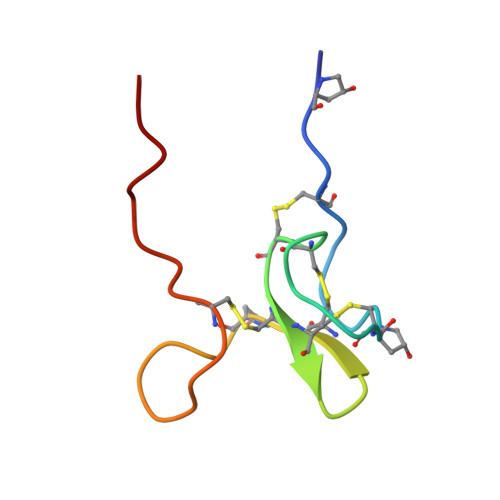Structure and sodium channel activity of an excitatory I1-superfamily conotoxin.
Buczek, O., Wei, D., Babon, J.J., Yang, X., Fiedler, B., Chen, P., Yoshikami, D., Olivera, B.M., Bulaj, G., Norton, R.S.(2007) Biochemistry 46: 9929-9940
- PubMed: 17696362
- DOI: https://doi.org/10.1021/bi700797f
- Primary Citation of Related Structures:
2JRY, 2P4L - PubMed Abstract:
Conotoxin iota-RXIA, from the fish-hunting species Conus radiatus, is a member of the recently characterized I1-superfamily, which contains eight cysteine residues arranged in a -C-C-CC-CC-C-C- pattern. iota-RXIA (formerly designated r11a) is one of three characterized I1 peptides in which the third last residue is posttranslationally isomerized to the d configuration. Naturally occurring iota-RXIA with d-Phe44 is significantly more active as an excitotoxin than the l-Phe analogue both in vitro and in vivo. We have determined the solution structures of both forms by NMR spectroscopy, the first for an I1-superfamily member. The disulfide connectivities were determined from structure calculations and confirmed chemically as 5-19, 12-22, 18-27, and 21-38, suggesting that iota-RXIA has an ICK structural motif with one additional disulfide (21-38). Indeed, apart from the first few residues, the structure is well defined up to around residue 35 and does adopt an ICK structure. The C-terminal region, including Phe44, is disordered. Comparison of the d-Phe44 and l-Phe44 forms indicates that the switch from one enantiomer to the other has very little effect on the structure, even though it is clearly important for receptor interaction based on activity data. Finally, we identify the target of iota-RXIA as a voltage-gated sodium channel; iota-RXIA is an agonist, shifting the voltage dependence of activation of mouse NaV1.6 expressed in Xenopus oocytes to more hyperpolarized potentials. Thus, there is a convergence of structure and function in iota-RXIA, as its disulfide pairing and structure resemble those of funnel web spider toxins that also target sodium channels.
Organizational Affiliation:
Department of Biology, University of Utah, Salt Lake City, Utah 84112, USA.















